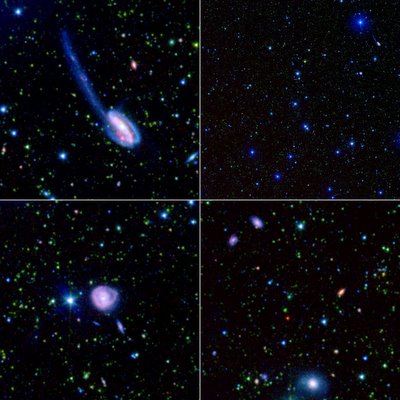
Years in the Making These images were taken by the Spitzer Wide-area Infrared Extragalactic Legacy project, which encapsulates one of the primary objectives of the Spitzer mission: to connect the evolution of galaxies from the distant, or early, universe to the nearby, or present day, universe. The Tadpole galaxy (top left) is the result of a recent galactic interaction in the local universe. Although these galactic mergers are rare in the universe's recent history, astronomers believe that they were much more common in the early universe. Thus, the project's team members will use this detailed image to help understand the nature of the "faint red-orange specks" of the early universe. The top right image depicts one-sixteenth of the survey field called ELAIS-N1. The bright blue sources are hot stars in our own Milky Way, which range from 3 to 60 times the mass of our Sun. The fainter green spots are cooler stars and galaxies beyond the Milky Way whose light is dominated by older stellar populations. The red dots are dusty galaxies that are undergoing intense star formation. The faintest specks of red-orange are galaxies billions of light-years away in the distant universe. The bottom left figure features an unusual ring-like galaxy, called CGCG 275-022. The red spiral arms indicate that this galaxy is very dusty and perhaps undergoing intense star formation, which could have been initiated by a near head-on collision with another galaxy. The most distant galaxies that SWIRE is able to detect are revealed in a zoom of deep space (bottom right). The colors in this feature represent the same objects as those in the larger field image of ELAIS-N1. Image Credit: NASA/JPL-Caltech
Ok, enough of the explanation of the above picture and who it is credited to. I post this picture with the intent of revealing a horrible, dark, nasty secret about myself..... I am a Star Trek fan. Not fanatic, like the proto-typical Trekkie that you hear about. But, I do have some episodes of DS9 and such on my computer. I don't like the original series, but Next Generation and Voyager were OK. DS9 was my favorite. I also have a few Star Trek games on the computer. I also have a certain fascination with space/astronomy/stellar physics/high energy physics. I really wanted to be an astronomer or high energy physicist, but I lack the ambition or drive to become such. When I saw the picture on this post, I thought of how many people there have to be in those other galaxies. Humans can't be the only sentient beings that exist in the entirety of space. That's one of the reasons I like Star Trek, because it allows the possiblity of there being others kind of like us.
Now, I don't presume to say that the others who surely must exist in our galaxy and other galaxies must look something like us, but just that they are there is a happy thought.
What I still fail to understand is how people can say that God doesn't exist, and that all the infinite wonder that exists in space came to be because of a fortuitous chance. I throw the BS flag, 15 yard penalty, to quote my supervisor.
I just look at that picture, and I wonder what the others are doing in their lives. I wonder if they have some of the same experiences that we do. Just a mid-day musing...
Wednesday, November 02, 2005
Why Not?
Posted by Daishi at 11:50 AM
Subscribe to:
Post Comments (Atom)

3 comments:
Jordan, I know that you have felt uncomfortable about telling others that you like the Star Trek series'. The title of "trekie" is not always seen in a positive light. But there is nothing wrong with liking Star Trek, and I am proud that you would publicly display your personal preferences.
I love you, Goo!
As Douglas Adams once famously wrote:
"It is known that there are an infinite number of worlds, simply because there is an infinite amount of space for them to be in. However, not every one of them is inhabited. Therefore, there must be a finite number of inhabited worlds. Any finite number divided by infinity is as near to nothing as makes no odds, so the average population of all the planets in the Universe can be said to be zero. From this it follows that the population of the whole Universe is also zero, and that any people you may meet from time to time are merely the products of a deranged imagination."
well, ben, my figment of my imagination, i'm glad you're here to talk to.
Post a Comment